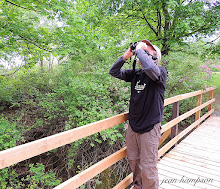Yes, it was after leaving our spotting scope for repairs to the mounting foot that Jean and I realized we would be scopeless during the OFO Carden Alvar trip. Viewing an endangered shrike hundreds of metres away could be difficult. No digiscoping either.
There were a few birders in the group that had scopes including trip leader Jean Iron. An excellent trip leader, Jean Iron always ensures that everyone in the group has observed the target bird before moving on. If a Loggerhead Shrike or Upland Sandpiper were too far for our bins, a view through Jean Iron's scope would be available.
After participating in and winning the Carden Challenge over a 24 hour period from 6:00 p.m. on Friday May 25 to 6:00 p.m. on Saturday May 26, Jean Iron did not look tired at all. Perhaps, it was the Carden Cup on display atop her vehicle. Her team was named the Yellow Rails and the four birders ticked 132 species during the competition. As Celebrity Birder, Jean raised over $11,000 for stewardship and bird habitat conservation by The Couchiching Conservancy on the Carden Alvar.
The first stop for the OFO group was Wylie Road. We walked along the narrow gravel road looking for grassland species and the Prairie Smoke was in full bloom.
Grasshopper Sparrow and Wilson's Snipe were added to the year list and we had the best look at a Loggerhead Shrike, ever! Jean and I have visited the Carden Alvar twice and all our views of shrikes have required a scope. This trip, a lone shrike was resting on a pole, a mere distance from the road. It would have been nice to capture a digiscoped image though.
Continuing north on Wylie Road, we reached the Sedge Wren Marsh. We ticked our lifer Alder Flycatcher and Sedge Wren in May of 2010 at this spot and repeated the observation in 2011. This year, an Alder Flycatcher was heard singing but the rapid chatter of the small wren was absent. Marsh Wrens (FOY) were heard and spotted but due to beaver activity in the area and rising water levels, Sedge Wren was missed for the first time in many years.
While scanning the marsh west of the road, I heard the whinnying call of a Sora. Though we had our backs to the marsh east of the road and the call was short, a few of us were still able to identify it. I asked the fellow standing next to me if he heard the same call. He did. So did his wife and Jean as well. That was the important part. Jean confirming that she heard the Sora added the small rail to our year list.
At the Kirkfield Liftlock, a FOY Cedar Waxwing tick during our lunch. Once again, we have to travel north of Lake Ontario to obtain this species for the year list despite covering a number of spots in the Niagara Peninsula prior to this trip.
At the heron rookery on Shrike Road, we had an added bonus to the annual Blanding's Turtle observation. A Great Horned Owl (FOY) had no objection to using a former home of a Great Blue Heron family to raise its own young. Jean expanded her digiscoping skills by using a scope she was unfamiliar with and managed to capture a decent image.
We moved further up Shrike Road and added Upland Sandpiper to the year list as a small flock flew past our group.
Approaching Canal Lake on Centennial Park Road, we added Green Heron and Great Crested Flycatcher to our year list and despite it being virtually identical to our first observation earlier in the day, we ticked our second Empidonax of the trip, a Willow Flycatcher.
As we crossed the causeway, I was looking for our streak of repeat species to continue. In 2011, the small pond on the island produced a lifer Least Bittern. An unobstructed view of this bird occurred after playback but this year, an inquisitive bittern did not emerge from behind the reeds.
The group ended the trip searching a few spots along Prospect Road. In the marsh, we observed a Virginia Rail in flight as it popped up from the reeds There was a second rail close to the road but it remained well hidden.
There is a variety of habitat along this road including scrub. So after ticking waterfowl, flycatchers and rails you move a bit further south along Prospect Road to look for Emberizid species hiding in the brush. We stood at the edge of the road scanning the scrubby landscape for singing sparrows. OK, there's the Song Sparrow and a Chipping Sparrow but what Jean and I really needed was the appearance of a Clay-colored Sparrow. It did not take long for the group to pick out the insect-like buzz of a Clay-colored Sparrow. No visual observation this year but it still counts.
At the end of the trip, the year list stood at 183 species. Not bad if I want to succeed in beating last year's total of 216. There are some species that I cannot afford to miss and then there are few (not too many mind you) that I'm willing to let slip by. Missing Sedge Wren and Least Bittern would be be tolerated as long as the dependable ticks keep me ahead of the game. The month of June would be spent hitting spots in the Niagara Region for the reliable species until the migrating shorebirds arrived.













I guess its better than Sleepless in Seattle!
ReplyDeleteOne can feel lost without the right equipment. I forgot binoculars once--not a good move while birding!